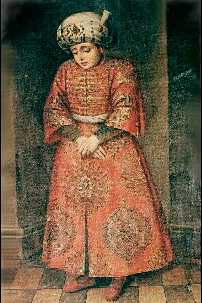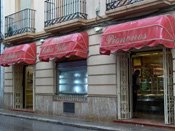
You could easily drive through the little town of Santa Fe without realising its historical significance.
- This small town of about 13 thousand (located about 11 km from Granada city) was built in 1490 by Isabel and Fernando as the base camp for their assault on Granada, the last Moorish outpost on the Iberian Peninsula. It was strategically built blocking the Río Genil and hence communication between Granada and North Africa.
- It was here that the monarchs signed “Acuerdos de Capitulación de Santa Fe” (25th April, 1491). This was the truce wherein Boabdil (last Nazarí king of Granada) agreed the handover of his palace and city. Later, whilst leaving the city, Boabdil looked upon Granada for what would be the last time; he began to cry. In what is one of Spain’s most poignant quotes, his mother said llora como una mujer lo que no has sabido defender como un hombre (to cry as a woman for that which he could not defend as a man).
- In what was a busy year, the Monarchs also signed the other “Las Capitulaciones” on 17th April, 1492. These named Christopher Columbus the “Major Admiral of the Ocean Sea, Viceroy and Governor General of the Discovered Lands” and finaly approved the financing of his trip to discover an alternate route to the Indies.
Besides visiting the town for its historical significance, you can enjoy its culinary achievement; Piononos. This pastry is named in honour of Pope Pio IX (1792-1878); pope for a record 31 years and often lampooned by his Italian name Pio No No (wikipedia explains that he was considered quite conservative).
I had eaten Piononos loads before and never been wowed (upon reading this, local outrage may cutoff my future blog contributions). Their home rightly changed this opinion, but probably means that I’ll only ever eat them in Santa Fe. They are truly delicious; a custard filled pastry topped by burnt sugar.
Double risk on my point… we haven’t yet tried the recipe and it is translated… Blanca explains that this is basically a double recipe; one for pastry cream (creme patissiere) and the other for genoise.
¼ l milk
200 g sugar
2 eggs
40 g soft flour
½ tsp lemon grated
For the biscuit:
3 yolks egg
5 whites egg
60 g sugar
80 g cornstarch
2 sp cold milk
1 cup rum
25 g cinnamon in dust
Pastry cream is a very versatile cream used in many cake and pastries. It is a thick custard cooked on the stove from milk, eggs, sugar, flour and cornstarch (as thickener). For the cream – boil the milk, sugar, cinnamon and lemon. Remove upon boiling. Beat the eggs and flour. Add the boiling milk. Return to a medium-high heat and whisk until it comes to the boil. Cool with a plastic wrap to prevent a skin from forming.
For the biscuit – beat the yolks with the sugar and milk. Heat and add the cornstarch. Beat the eggwhites until they peak. Add the eggwhites to the mixture. Pour onto baking paper in a linear fashion (approx 2 inches). Place in the oven for 10 minutes. Make a syrup with water, sugar and soak the genoise. Spread the pastry cream and roll. Sprinkle sugar on top and toast in the oven. Serve cold.
Vocab builder:
Empapar – to soak
Almibar – syrup
Almidón – cornstarch
Canela – cinnamon
Rallar – to grate
Regar – to irrigate
Placa - numberplate (you may well wonder how this made it into the vocab)
Harina pastelera – soft flour
Capitulación – capitulation
Rendición – surrender
Virrey – viceroy
Broadband connectivity in the South of Spain obviously felt that I was a little bit ahead of myself by blogging early last October. This is the reason for my one month absence. Hopefully this blog signifies service recommencing as normal.
------------ STOP PRESS "CASA YSLA Y LOS PINONOS" ------------

I have just been on the web to see if I could find a picture of the pastry shop where we had the famous Pionono. Not only did I find a picture, but a lot more about the Pionono. The pastelería is called "Casa Ysla" and is none other than the originator of the Pionono.
The history is amazing... in 1897 Ceferino Isla González (intern to Manuel “el Gallego”) opened his own store on Calle Real, Santa Fe. He was very devoted to the Virgin and wanted to pay homage to Pope Pius who, in 1854 had issued the infallibly defined the "dogma of the immaculate conception" (essentially that Mary was free from original sin). In this way, he decided to create a new pastry. The aim was to not only carry the name of the pope, but also his likeness; cylindrical and somewhat chubby.
In 1916, the King (Rey D. Alfonso XIII), whilst visiting a friend on a nearby farm, ate some Piononos for his afternoon snack. He was so taken by the delicious flavour that gave the title of official providers to the Royal House to Casa Ysla.

... Spain... go for the pastry and stay for the politico-religious history.




3 comments:
Oh so the pastry is that recent? I was planning to post on it and initially thought they're a bit older because piononos are quite common in the Philippines. By 1898 Spain was on its way out. Hmmm... it must've been the nuns. [puzzle... puzzle...]
Posted by Karen
Hey, here there are a lot of news about pionono: Piononos
Bye guys
Posted by Mario
Hi Mario, thanx for the very interesting site.
I found another one: Pionono.biz (english language, not spanish)
Posted by Angel
Post a Comment